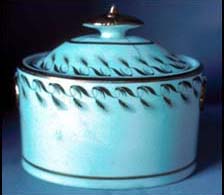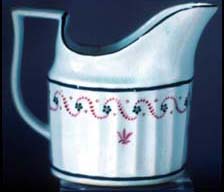|

|

|
Minton,
Sugar Box, Pattern No. 44, c.1800
Cumming Collection
Gardiner Museum of Ceramic Art |
Minton,
Creamer, Pattern No. 6, c.1800
Cumming Collection
Gardiner Museum of Ceramic Art |
| |
Introduction To
The Cumming Study Collection
The Cumming Collection began, innocently enough, with the
purchase by Robert and Marian Cumming of a pair of Sevres-style
vases, vaguely described by the antique dealer as 'Continental'.
With a bit of research, they turned out to be English, mid-19th
century, made by Minton. Five years later, a chance bid at a
1983 auction yielded a magnificent, 'Continental', Sevres-style
plate which also proved to be by Minton. However, this prize
came from a large service ordered by Buckingham Palace in 1863
for the wedding of Edward, Prince of Wales and Princess Alexandra
of Denmark. The service is in the Queen's Collection at Sandringham.
Bob was now hooked on collecting English porcelain and he decided
to concentrate on the Minton factory. There were knowledge gaps
for the company's early years which offered the challenge of
historical research, and he pursued this vigorously, in parallel
with building a study collection of Minton's first period of
bone china prior to 1816.
Until 1796, a controversial process patent precluded the legal
production of bone china as we know it. But that did not stop
the Staffordshire potters from experimenting and, when an attempt
to extend the patent failed in Parliament, Joseph Poulson was
among the first to spring into production in his new china pottery.
He also formed a marketing partnership with Thomas Minton who
had built a near-by earthenware pottery. When Poulson died in
1808, Minton rented the china works from his Estate and carried
on under his own name until he abandoned china production in
1816. In 1824, he built his own china pottery, and then under
his son, Herbert and his successors, Mintons occupied a pre-eminent
position among English ceramic manufacturers throughout the
19th century.
The time-frame of the Collection began to widen as interesting
pieces were acquired from later in the 19th century. That lead
to a conscious decision to build a broader study collection,
based exclusively on Minton, which would illustrate the evolution
of English ceramics across the 19th century.
As the Collection developed, it outgrew display and storage
space in the Cumming's Ottawa residence. Also, as Bob wanted
to see it preserved and utilized for public education, an agreement
was reached for the donation of most pieces to the George
R. Gardiner Museum of Ceramic Art in Toronto. About 300
examples are now in the museum, and more will be added in due
course. Thirty examples have also been donated to the Winnipeg
Art Gallery (W.A.G.)
and another thirty to
historical Earnscliffe, the Ottawa residence of the British High
Commissioner.
Every piece has been photographed on print film and slides as
it entered the Collection, and each item is catalogued with
full research details. These thick catalogue binders constitute
an invaluable research resource which, along with extensive
material in the collection archives, will be donated to the
Museum.
The Collection at the Gardiner
Museum and W.A.G. is available to researchers and serious
collectors on application to the Museum curators.
Lightly represented or missing groups in the study collection,
e.g. figures, parian, majolica and tiles, have been selected
quite deliberately since storage space at the Gardiner Museum
is limited. Also, suitable examples are readily accessible for
exhibitions from the Royal Ontario Museum or from private collections. |
Selected Examples From The
Collection
(A) First Period - c. 1796-1816
Note: Although this cannot be confirmed, pieces with the pseudo
- Sevres mark are presumed to have been made after Joseph Poulson's
death, November 30, 1808 when John Turner II became Works Manager.
Although some pieces may carry a low pattern number, it is thought
that they were later orders.
Click on photos to enlarge. |
 |
 |
 |
 |
 |
 |
 |
 |
| |
 |
 |
 |
 |
 |
 |
 |
 |
(B) Post - 1824
Note: When Minton began making bone china in their new pottery
in 1824, they started numbering patterns at No.1 again.
Click on photos to enlarge. |
 |
 |
 |
 |
 |
 |
 |
 |
| |
 |
 |
 |
 |
 |
 |
 |
 |
| Photography by Victor Muscat,
Ottawa, Canada |
| A more comprehensive review of the Collection and its historical background can be seen on www.cummingmintoncollection.org |
|
THE
CUMMING CERAMIC RESEARCH FOUNDATION©2002-2003
ALL RIGHTS RESERVED.
|





































